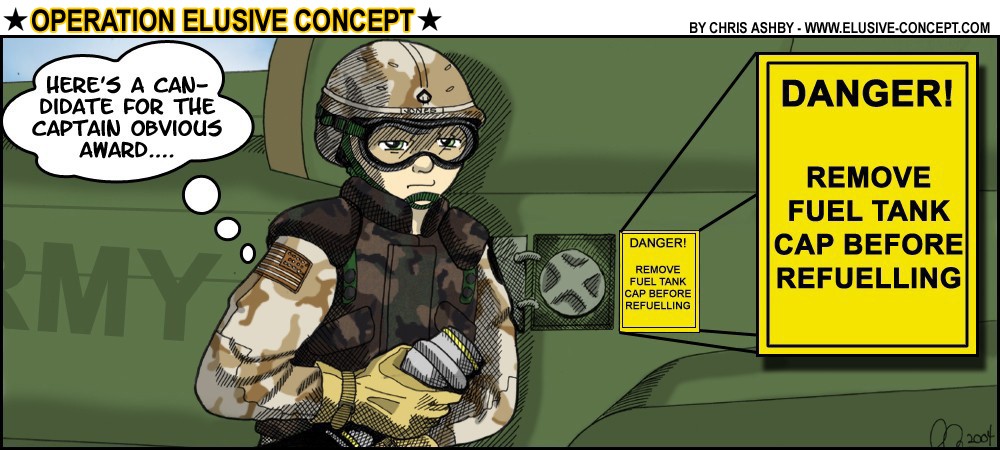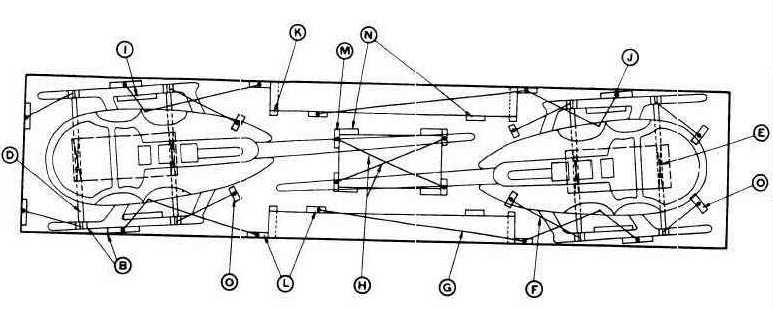Ground Mobility for Army helicopters: the all-or-nothing paradigm solved
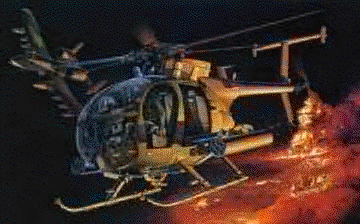

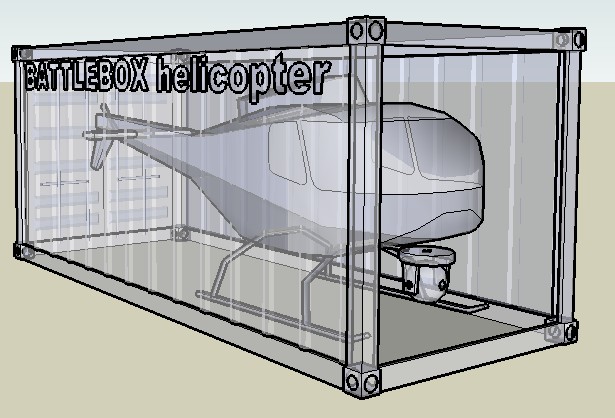
U.S. Army Interim Brigade Combat Teams (IBCTs) unveiled, but not a single helicopter is in the allegedly new "advanced", "combined-arms" force structure using 1950's technology road-bound, vulnerable rubber-tired armored cars.
2002. Afghanistan.
A damaged AH-64A Apache helicopter is blown in place by friendly personnel rather than recovered.
What do these two incidents have in common?
First, a helicopter is an all-or-nothing machine; either its fully functional and flying at 100 mph (it can hover but that's not the point) or its broken and stranded---absolutely not mobile at all! So in the rarified air of mountainous Afghanistan even a mighty CH-47 Chinook cannot lift a wounded Apache---its all DEAD WEIGHT so they blew it up. Goodbye $24 million dollars of aircraft!
So why then did General Shinseki exclude ANY Army helicopters from the allegedly "combined-arms" IBCT? Army Aviation is one of our combat arms.
Because helicopters are a pain-in-the-ass!
They cost too much to operate and require too much fuel; and like M1 Abrams heavy defensive tanks that also have turbine engines, helicopters have become persona non grata (PNG) in the U.S. Army even though we are repeatedly in situations where their 3rd dimensional mobility is grudgingly necessary to get to a fight. We can and we should put more fuel miserly diesel engines in our fleet of M1 heavy tanks to give them an offensive 500-mile range, but we cannot do the same to our helicopters and have them fly.
So why 5 decades after the birth of the helicopter is its very utility and future in question on the modern battlefield?
What you are about to read is the most shocking and dramatic revelations about the military art and the nature of things in the 21st century that you may ever read. I ask you to hold back knee-jerk reactions and possible anger and to give me time to lay out my case and follow its logic to its inevitably shocking conclusion. We will not even broach the X-FLOT we-can or we-cannot with low-altitude, low-speed helicopters debate. Whether helicopters can do deep attacks or not is NOT what is killing them.
The problem with aircraft: they are NOT aircraft!
Today, in 2002, what we call "aircraft" are NOT actually AIRcraft let alone 3D vehicles, they are 3rd dimension vehicles--there is a huge difference---and they can only fly for a short time. In fact, they are not AIRcraft that can chose to fly or not fly at will over the earth; they can only fly for a relatively short period of time from a narrow set of pre-surveyed sites and they MUST land well before running out of the fuel required to generate power to create thrust for aerodynamic lift.
When both fixed wing (1900-1920) and rotary wing flying machines (1940-1950) were born, their creators imbued by zeal proclaimed that their new mobility devices would become the "automobiles" of the air. Yet 10 decades later these dreams have crashed and burned in the hard realities of planet earth. The common man has not jumped into these machines and started zipping around the sky like the TV cartoon Jetsons portrayed. Why?


Leaving the earth's ground gravity is an un-natural act, to do it in a heavier-than-air machine that creates lift by air pressure differential lift requires enormous power and fossil fuel to create that power for thrust. The sad truth is that a flying machine and all who are in it are in jeopardy once they are in flight--if anything happens to pilot, engine or airframe (PEA), the force of gravity will bring them back to earth and a crashly ruin. Now we can and we should realize this weakness and provide a means of escape--a recovery parachute if PEA fails to turn atmospheric pressure into a deceleration device to bring machine and humans back to earth before altitude and life runs out into ground impact and death. We should also make our flying machine shapes as efficient as possible using the Burnelli principle so in event of engine failure we have maximum gliding lift and the strongest cabin structure to be crash-worthy. All this being said and yet to be done, the fact remains that flying machine travel is not safe enough that it can be done in a cavalier manner akin to a ground vehicle used by the common man/woman who require simple transportation not requiring extensive pre-meditation. Why is this?
In contrast, a ground car (automobile) is not in jeopardy if its machinery becomes degraded or stopped, its still grounded to earth--its motion does not place its survival in any kind of jeopardy from the perspective of its connection to the earth. Yes, if the ground vehicle is steered to a position where the earth no longer supports its weight or if motioned forward into a collision with another object, the ground vehicle kills and it kills terribly each year in the U.S. However, the ground automobile is not in the dire jeopardy of being only seconds away from all its potential energy being turned into a crash/explosion the instant it stops functioning fully.
Flying machines are not the same or even close in their relationship to the earth as ground automobiles, which is stating the obvious. A flying machine opposes nature and is in constant latent jeopardy; if function is degraded its in dire danger, aircraft cannot fly and make-plans-as-they-go-along, flight is a pre-meditated, calculated move with a place to land projected already and planned in advance at a comfortable, safe time long before flight must end (running out of fuel). In a sense, what we call "aircraft" today are not yet real "aircraft" but flying machines as diesel-electric submarines were not really submarines but submersible boats. Current flying machines are not true aircraft that can fly indefinitely and wherever at will; but actually flyable wagons with a very short pull cord where they can go and not go! Only when long-term power in the form of say nuclear fission can be applied to earthly flying machines will they become true aircraft as submarines were born when they became nuclear and could stay submerged in their medium indefinitely in the span of consciousness of human beings. Or some kind of anti-gravity aircraft were to be developed. Think of Jules Verne's "Master of the World"--that's an aircraft.
Ultralights come closest to being true aircraft, because their lightness makes them easy to enter and leave flight from almost anyplace on earth with almost no take-off or landing run, but even their hours aloft are numbered to a short temporary span. Lighter-Than-Air blimps and dirigibles though able to stay aloft for days, weeks due to their gas buoyancy still need fossil fuel for their engines to steer them and not be at the fatal mercy of the winds.
In fact, as flying machines have increased in complexity flight has become more difficult to achieve not easier-------its become actually harder and harder to enter the air and leave the air. In the case of the U.S. Army's helicopter Aviation units their huge institutional costs and in-the-field-labor have almost put themselves out of business, making themselves persona non-grata (PNG) to the rest of the ground Army. Shocking but true.
Ground units can move forward and never be in survival jeopardy from the earth itself baring an earthquake or flood...they can develop the situation as they go along. Army flying machines after taking flight must have a place to land---they cannot take flight frivolously and improvise; a real lack of flexibility---thus, they are not 3D vehicles but vehicles that can only temporarily fly in the 3rd dimension of the air. Working around the fact that aviation units must have suitable place to land (weather information to base flight plan decisions, air traffic control, the list goes on and on) makes them a pain-in-the-ass to ground units, a "noose" around their "neck" that many commanders in short sightedness not recognizing all that could be gained decide not to "hang" themselves with.
The V/TOL dream did not pan out (so far)
In the early days of fixed-wing aviation, prop-driven airplanes could land and take-off easier than they do today, from grassy cow pastures. In WWI and WWII, almost anyplace could become an airfield---there was a synergism of engineers to improve and maintain runways working towards helping the flying machines fly, and the latter didn't ask for much help beyond fuel/maintenance. Some long for those days of the simpler "stick and rudder" flying machine. However thousands also died with that stick in their hand as their machines had to return to earth by design or accident and the concept of a parachute even on the pilot's back let alone embedded into the aircraft itself took a long struggle against bloated egos. Today most pilots still do not wear parachutes in disrespect for Murphy and the forces of nature in general. We continue to live in denial and crash and die.
As performance in flight demands grew into heavier and heavier jet-powered aircraft, longer and longer take-off runs to create lift over fixed wings were required and the ground existence aspects of flying machines became secondary or ignored. The Army Air Force broke away from the mud and grime of the field Army to become the hard runway and air base dependant (and pampered) USAF. The U.S. Army after WWII lost 3rd dimensional mobility. The rotary wing helicopter that creates lift by spinning wings through the air that can land or take-off vertically and thus not need any runways at all, seemed for awhile to be the answer to return 3rd dimensional mobility to the Army. With the advent of powerful jet turbine-engined helicopters just prior to the Vietnam war, the hopes of a simple flying machine that could completely replace ground vehicular travel Jetson-style seemed fulfilled as expressed in the Howze Board report which created the originally flawed Air Cavalry structure that was later improved when teamed up with armored ground cavalry with tracked all-terrain M113 Gavin-type armored fighting vehicles for a 2D/3D synergism.
Even then, helicopters as the mobility solution for all problems didn't work as well as hoped.
Helicopters require enormous amounts of fuel to fly---really enormous amounts, and thus once in the air they were living on even less borrowed time than fixed-wing aircraft. After dropping off ground troops on foot, they HAD TO fly back to a safe "rear" area to exist primarily as an immobile wagon until refueled and rearmed. The grunts back in "Indian country" had to fight the enemy with whatever they carried on their backs. Thus, armored ground cavalry fighting alongside was added to the force mix and this worked well when the two force types could work in concert with each other.
Realizing this, we have undertaken an effort to wed light tracked tanks that can be transported by helicopters and fixed-wing aircraft so after delivery, the grunts fight the enemy with guaranteed superior armored mobility, firepower and levels of supply. To give helicopter rotors a lift, we propose Piasecki-type fixed-wings and pusher tail units to create compound helicopters to double speed and ranges as well as reduce maintenance demands. We call this initiative "Air-Mech-Strike".
However, the helicopter itself still requires a safe place to "conk out" for the majority of the time since it cannot actually stay still in the combat arena, it has to burn fuel to fly overhead---this logistical burden has made it persona non grata with the ground troops for being too far in the rear when not in the fight and requiring vast amounts of fuel when it is.
The vectored thrust Harrier jet was found to need a rolling take-off to carry a decent bombload, and its hot engine exhausts by its fuselage fuel tanks make it an exploding funeral pyre if hit by enemy ADA so it didn't pan out as a V/TOL Close Air Support (CAS) platform. The answer is a fixed-wing attack aircraft that can be piloted in person or remotely that can take off from very short distances and operate close to ground troops using its fuel efficient wings to stay aloft continuously overhead to be already in position to swoop down and gun strafe the enemy the instant ground troops request MANEUVER AIR SUPPORT (MAS). The U.S. Army will have to relearn the synergism of engineering short runways for small MAS aircraft (OV-1 Mohawk size or smaller) to operate from.
The Army needs true 3D flying machines with ground mobility
Realizing that we do not have actual aircraft but in essence, wagons-that-fly in the 3rd dimension only, what about the other 2 dimensions, length and width on the ground? Why are they so important to add onto a flying machine's capabilities?
Its either ALL: Flying
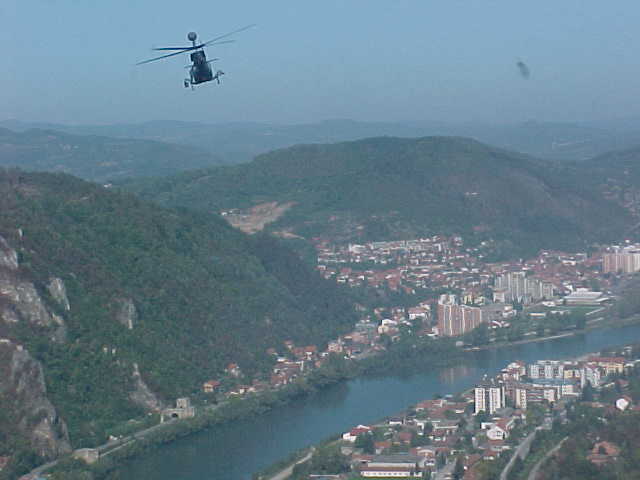
...or NOTHING: grounded

The Maneuver Gap: when aircraft cannot fly they become farther and farther from the action to point of irrelevance
Another truth not admitted is that in some weather conditions, the "Battle against the Earth" gets the best of us and aircraft are grounded. When aircraft cannot fly, ground maneuver units still have to fight. This is a huge reason why we need to still have field artillery and naval guns to ballistically launch ordnance without need of aerodynamic flight-friendly weather. The Battle of the Bulge was nearly a strategic defeat because the Germans attacked in the dead of snowy winter when our aircraft could not fly. The recent sand storms in our two latest wars against Iraq resulted in ground maneuver elements not having ANY air support at times.
Where was Army aviation and all its helicopters as the rest of the Desert Storm and OIF forces in ground vehicles advanced?
Were they not at a fixed, static base becoming farther and farther away from the action as maneuver forces on the ground in tracked AFVs moved ahead? With helicopters having such limited range to begin with, were they not becoming irrelevant to the fight? Wouldn't more and more fuel be required to get them to the ground fight as this gap increased?
Therefore, wouldn't it be beneficial then that when fighter-bombers and helicopters are grounded by bad weather---they become GROUND MOBILE by being towed in armored ISO container "Battle Boxes" to conserve fuel and flight times following in trace of the maneuver elements, ready to fly as soon as the weather cleared from hasty FAARPs?
What's the point of V/TOL helicopters if they cannot operate alongside ground forces like Stukas and P-47s could in WWII? If our helicopters have become so needy of pamperment then maybe its time we went retro to a simpler, fixed-wing A-1 SkyRaider, OV-1 Mohawk or A-37 Dragonfly type aircraft that has good enough short take-off and landing capabilities that they can be towed in battle boxes and put into the air on the spot without all this we need an air base, we need this, we need that drama?
We know that the Army lost its OV-1 Mohawk two-seat fixed-wing observation/attack aircraft because Grumman was bought out by Northrop who wanted to push their JSTARS 707 airliner BS as the answer to battlefield reconnaissance. The Army should have hundreds of OV-1s with humans inside that can scout for the enemy and VERIFY by human investigation what's sheep dung and what's T72? If we do this smart, the aircraft could be unmanned if the enemy air defenses are too hot-ie it becomes a defacto UCAV.
The good news in all of this is we can fix this.
The solution is to also give Army helicopters GROUND MOBILITY IN THE FIRST 2 DIMENSIONS, to make them defacto 3D mobile vehicles. The Army's OH-58D Kiowa Warriors, AH-6 Little Birds, UH-60 Blackhawks, RAH-66 Comanches, AH-64 Apaches and even large CH-47D Chinook helicopters can all be placed on a Heavy Equipment Transporter System (HETS) trailer or a Palletized Loading System (PLS) flat rack and transported by an Army truck over the ground to wherever they need to go to. The fixed-wing MAS aircraft the Army needs could also move by PLS flat rack or better yet towed by their own landing gear if designed for this or in a small trailer. Coupled with PLS transport flat racks and a prime mover truck, the majority of the Army's helicopters become for the first time in human history, 3D air/ground vehicles---capable of movement in all 3 dimensions. In fact, Delta Force has clandestinely transported Little Birds in panel trucks for years and achieved the 3D air/ground synergism---its now time for the rest of the Army to attain full 3D maneuver capabilities.
In fact, the Army Requirements Document for the AH-64D Apache LongBow states that IT MUST BE TRAILER MOBILE:
AH-64 Apache - Military Aircraft
http://216.239.41.104/search?q=cache:HaGTX8xrWeMJ:www.fas.org/man/dod-101/sys/ac/ah-64.htm+c-5+carry+ah-64+helicopters&hl=en&ie=UTF-8
Transportability requirements were initially identified in the ORD and further defined in the AH-64D System Specification. Both configurations of the AH-64D, including any removed items and appropriate PGSE, shall be capable of being transported aboard C-141B, C-5A, or C-17 aircraft. The aircraft shall also be capable of being transported and hangar stored below decks in the landing platform helicopter (LPH) type carrier, Fast SeaLift ships, Roll-on/Roll-off, LASH, SEABEE ships, and Military Sealift Command (MSC) dry cargo ships. Additionally, the aircraft shall be transportable by military M-270A1 trailer and commercial "Air-Ride" trailer or equivalent. For aerial recovery, the AH-64D with MMA will be externally transportable by CH-47D aircraft using the Unit Maintenance Aerial Recovery Kit. Two AH-64D plus one FCR aircraft will be transportable by C-141, six AH-64Ds (with a minimum of three FCR mission kits) are transportable by C-5, and three AH-64Ds and three FCR mission kits are transportable by C-17.
In THEORY U.S. Army Aviation units can co-exist with ground maneuver units easily because of V/TOL and trailer capabilities. What does this get you?
MYTHS & EXCUSES TO STAY FAR AWAY FROM THE ACTION
1. Our UH-60s/AH-64s/CH-47s need pampering and need to stay out of the dirt and to the mythical "rear" as possible
2. Helicopters cannot move with maneuver units due to excessive baggage (why we want helicopter ground mobility trailers)
3. Helicopters cannot co-locate because the excessive noise and space they need which would betray ground unit's positions to the enemy
4. So Helicopters units are always SEPARATE from ground units.
Thus, when ground units move THEY NEED THEIR OWN PLACE TO FLY INTO, unless we make everyone a big happy family for the first time (in war) and secure a FOB like Cobra in Desert Storm I. The ground maneuver unit is not going to invest in securing an area to be a Forward Arming And Refueling Point (FAARP) for those aviators, @#$%^% them, we have an enemy locate, close with and kill. They can secure their own FAARPs. Aviators who don't want to get that close to ground combat will say they don't have the combat power to secure and defend their own FAARPs. If they are daring they will gamble and go into a FAARP and hope the enemy doesn't @#$#%^% with them because they indeed do lack ground combat power to secure their own FAARPs.
5. Harming the helicopters while being towed is a technical problem which can be solved by proper cushioning.
6. If we got helicopter mobility trailers this would solve all of these problems so everyone co-exists. When grunts see helicopters NOT flying they can then raise the questions of "why?". Then someone will have to face the truth that our large helos are overly complex and fragile and unfuck the situation. Get some simpler fixed-wing observation/attack aircraft, too so we don't go broke, and get 24/7/365 air cover.
7. This universal DoD push for fixed-wing UAVs is tacit admittance that the all-helicopter Army force structure is a failure. Trailers would reduce the number of flight hours before maintenance, conserving flight for when it counts: COMBAT not just moving from point A to B. A helicopter is always living on limited borrowed flight time.
An aircraft designer recently made some strong points for ground aircraft mobility:
a. We box/containerize UAVs to protect from the elements
We shrink-wrap helos to sea ship them
b. Broken aircraft can't fly
There's a lot of broken Army helicopters at any given time!
Hence another built-in excuse not to move forward and co-locate with ground maneuver forces to be more responsive.
c. Crews need rest, they can get a break if we truck them and their aircraft
d. Things being armored for the dangerous NLB
We could and should develop a large ISO container that is truck mobile to sea ship UH-60s, CH-47s, AH-64s instead of the fragile plastic shrink-wrap non-sense. The ISO lined with kevlar would protect the bird's identity and speed their handling from port to combat zone.
Here's what he said:
"For small unmanned aircraft, such as U.S. Hunter, U.S. Firescout, or Swiss Ranger, you would in theory have several in boxes at the start of a conflict, when only a few are out. You would usually not break all of them out before use, as that exposes them to environmental damage.
UK logistics emphasizes use of ISO containers, and movement inside the ISO container is convenient. U.S. forces may be learning a bit from our cousins on that score. The ISO container is a good size, protects its load, and can be dropped off for unloading while the prime mover goes about its tasks. A 5-ton truck can carry a 20 foot ISO container, and pull a trailer with another 20 foot ISO container. That is a lot of kit to provide to a forward unit.
Another reason, would be if a mechanical problem forced an aircraft down, and you popped it on a trailer to get it back to a maintenance area.
For manned aircraft, you may desire to move the base, while the aircrew rests. Aircrew rest is often a greater constraint than aircraft readiness, and trailering aircraft would permit the crew to get a bit of rack time, even if it was in a jouncing caravan."
Mobile Forward Arming And Refueling Points on the Non-Linear Battlefield
An Army combat AH-64 attack helicopter pilot expounds on the protected trailer ground mobile helicopter concept and some criticism that have been raised against it:
Mike originally addressed the issue of trailers for several beneficial reasons. If you think conventional MTOE organization, than I'm with you. It doesn't really make any sense. We did everything in Afghanistan by air, and still do (in the main AOR). Putting the aircraft (A/C) on trailers creates an unnecessary risk, and lucrative soft target. $25 Million dollars could go out the window with a simple A.T. mine, or RPG-7.
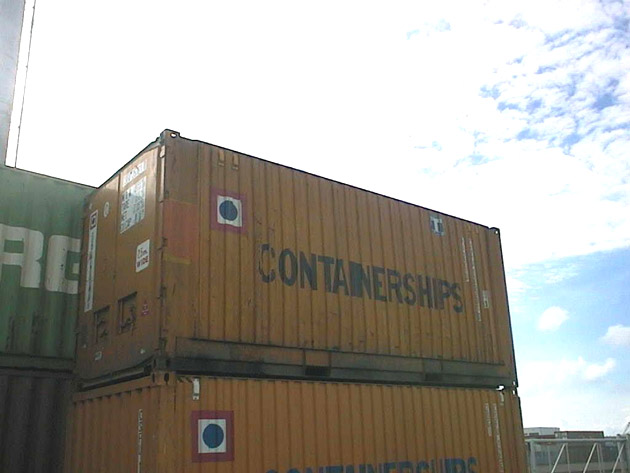
However, on the asymmetric, less conventional side of the argument (along the border regions), box trailers could provide the logistical tail needed to decentralize very heavy air-base maintenance operations. They (trailers) would have to look similar to other trailers in the Army inventory (for EEFI). You put your maintenance crew chiefs and maybe an armament team on several armed trucks including some refuel assets. These assigned enlisted guys hold 2 MOS's: 11B Infantry and a 15 series (aviation skill set) so they're not tactical indigents if they should come in contact with the enemy. You don't need 77F and 55B to pump fuel and load rockets. Yes - fly the A/C in and around the AO, but link up for scheduled and unscheduled maintenance with your completely maneuverable roving maintenance/FARRP site.
QRF could be successful:
QRF missions are currently successful to some un-measurable degree at deterring attacks (at least that is what the J2 briefs can do with statistics). They are a failure, however, at quickly reacting to combat enemy forces. This mission would be more aptly named CDF (Continuous Deterrence Forces). If and when the hierarchy decides that an enemy movement or attack is worthy of aviation attack support, and the fleet is launched, the very light and maneuverable enemy is long gone. And if we are centralized at large air-base operations (or even 1 isolated FOB) the response time is not commensurate with the criteria for success.
Damage is done.
The introduction of highly mobile (stay out in the field for about seven days at a time) FARRP's would introduce a more effective mission against rogue rural bands of Islamic Fundamentalist fighters in the hard-to-reach border regions. Tactical risk mitigation could be achieved relatively easily with a combination of CAS, OP's, and team UAV's.
What could the trailer's provide?
The trailers could:
1) offer armor against light weapons and RPG's to maintenance crews that are en route or stationary while servicing A/C in the fluid environment.
2) provide mobile maintenance support, refueling, and armament to forward (away from the flagpole) operations.
3) A/C, when parked for crew rest, don't have to be exposed to environmental, and enemy threats. They would get boxed up, and still be quickly launchable. They also don't advertise to the enemy that they are high value target aircraft.
4) Worst case scenario, the crew could drive a few hundred meters masking behind natural obstacles, launch the helo, and suppress the threat.
A critic retorted:
"The only thing, I'd want a trailer for is for spares, fuel and tools. Not for carrying an aircraft. Quickest way to break a helicopter has got to be X-country travel in a trailer!"
This is exactly what I'm talking about. We are not going to transport a helicopter to the LD via trailer. But when the helicopters land for 100 hour or phase maintenance, wouldn't it be nice to have some type of direct-fire protection for the airframe and crew? Helicopters can land on a dirt patch, but did you know that some AVN BDE's have standing policies in combat that only Chinooks are allowed to shut down at a FOB? And that is a worst case scenario. Have you ever tried to work on a rotor with it turning? :-) I agree with you that the helicopters can land and get service on any patch of ground. But what I am suggesting is that we empower aviation units to be effective direct fire combat assets. They can not currently effect QRF type mission success responding from an air base, or single FOB for an entire country.
This isn't a cultural problem, however it is fueled by sub-culture influences. Making the FAARP's more maneuverable is easy, smart, AND doctrinal. We just don't do it that way. The trailers allow for a more effective maintenance slice to be added into the FAARP equation. In order to "know your enemy and terrain" you've got to be out in it. Trailers would provide a simple force protection measure, and exponentially decrease reaction time for the QRF mission, convoy escort, whatever. The dual 11B MOS gives the aviation maintenance personnel a sense of need for situational awareness on the ground (something they definitely do not have).
Ground-Mobile Aircraft: an old German Idea
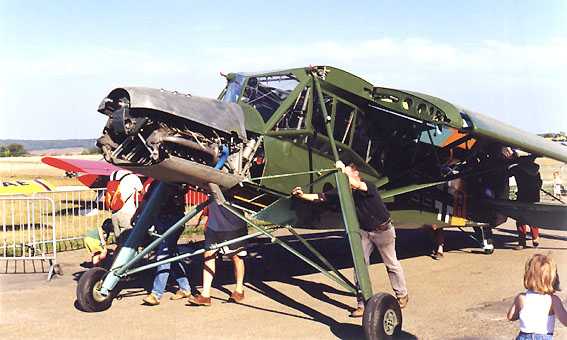
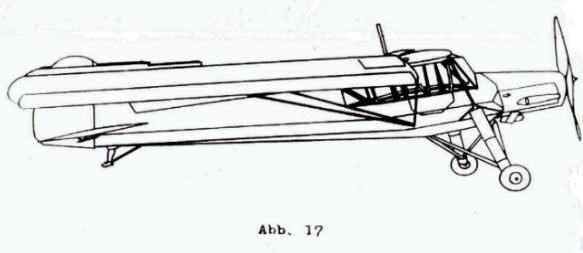
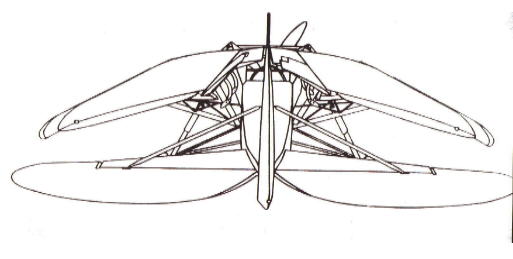
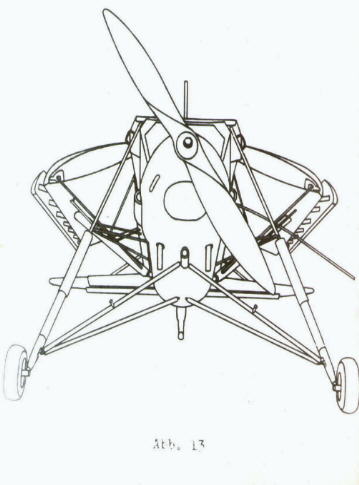
The first people to realize an Army aircraft has to be simple to operate and maintain (fixed-wing) yet be able to land almost anywhere (STOL) were the WWII Germans thanks to brilliant designer and WWI ace Fieseler.
http://rwebs.net/dispatch/output.asp?ArticleID=12 reports:
The Fi 156 Storch, as the design was quickly dubbed, could fly as slow as 32 mph, take off into a light wind in less than 150 feet and regularly land in 50 to 60 feet, less than twice its length. Its wings could be folded back along the fuselage, allowing it to be carried on a trailer or even tugged behind a vehicle.
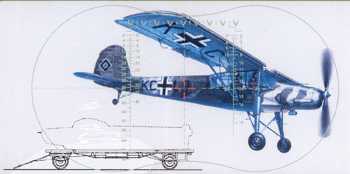
Storch and its trailer
See the photos/artwork above.
The French Towed F8 Bearcats by trucks into air bases during the 1st Indo-China War
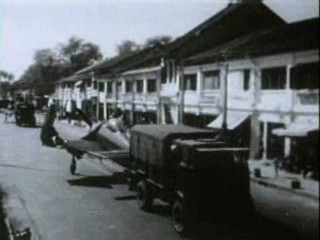
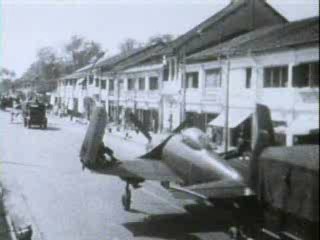
VIDEO
www.combatreform.org/attackaircraftinfirstindochinawar.wmv
http://worldatwar.net/chandelle/v3/v3n1/frcoin.html
ANALYSIS
Quotes:
"Initially, success proved more illusive in the field. French planners counted on achieving localized superiority in numbers and firepower to offset the superior human and material resources their opponents could muster in the overall theater of operations. Small, highly motivated bands of commandos would do the work of the much larger conventional armies that France lacked. This strategem presumed a high degree of mobility that was, unfortunately, all but unobtainable under the conditions prevailing in the colonies. In Indochina, trucks bogged down as soon as they strayed from a few easily blocked, ambush-prone roads."
COMMENT: Same is true today for Stryker/Humvee trucks in Iraq/Afghanistan.
"In North Africa, they got stuck in desert sand or broke down on rocky, mountain tracks. Armored vehicles proved incapable of providing adequate covering fire. Aging M-8 armored cars bogged down almost as badly as the trucks."
COMMENT: A metal box on top of wheels IS a truck. Not being able to comprehend the essence of things ruins tactical understanding and adaptations needed for excellence.
"In Indochina, Stuart and Chaffee light tanks could not ford the myriad waterways or use more than a handful of the bridges."
COMMENT: non-amphibious, steel tracked tanks--even light ones---are not suitable for 3D maneuver. We must use aluminum alloyed armored hull and amphibious M113 Gavin type tracked tanks to pursue elusive enemies with 3D maneuver.
"In Algeria, tanks proved too slow, too short on range, and too noisy for hunting small, dispersed bands. They gave away their presence before they could close with the enemy."
COMMENT: diesel engines increased range to 300 miles over gas-powered tanks with 150 mile ranges the French used. Today, Hybrid-Electric Drive (HED) promises at least a 30% increase over diesel engines with mechanical transmissions and electrical power only "stealth" mode. Band tracks can be fitted to eliminate track slap noise.
"Amphibious vehicles, particularly the little, jeep-sized Weasels, could operate anywhere in Indochina. But, with little or no armor and limited payload, they could neither survive nor fight."
COMMENT: the M113 Gavin combines Weasel-like amphibious, tracked mobility with armor protection and firepower.
"The Úlite commandos were frequently confined to a relative handful of garrison towns, where their special skills were useless and their vaunted morale vulnerable to boredom and frustration."
COMMENT: narcissists can be kept busy if they have Air-Mech-Strike 3D air-ground maneuver means.
"Air power was thus crucial to counterinsurgency strategy. When airplanes and helicopters replaced vulnerable, ambush-prone road convoys, the pace of operations and, with it, the likelihood of success increased enormously. Guerillas could not concentrate rapidly enough to overrun outposts before reinforcements arrived. Nor could they easily disperse or evade pursuit. Since route security was no longer necessary, far fewer troops were necessary. Major operations could be mounted by relative handfuls of professional light infantry-Foreign Legionnaires, paras and marine commandos."
COMMENT: but WHAT forces on the ground were aircraft delivering? Foot-sloggers once orphaned onto the ground found themselves fighting the enemy "even" or at a disadvantage. Ground vehicles not only are transportation means from A to B, THEY HELP YOU FIGHT, especially overcoming enemy bullets, grenades, mortars, RPGs. They also carry your supplies, too so you can fight longer. Connecting light tracked, amphibious armored fighting vehicles (TAFVs AKA "tanks") to aircraft transportation for 3D maneuver is an important adaptation required for non-linear warfare.
"It was even hoped that, in the absence of aerial opposition, modern combat aircraft could give the airborne force the firepower that light infantry had lacked in the past. With napalm, rockets, fragmentation bombs, and machine guns, a few pilots could, perhaps, do most of the killing from the safety of the air, before the infantry arrived. Survivors could then be kept constantly on the run and never allowed to rest or regroup. Most importantly of all, air power could greatly reduce the political vulnerability of colonial operations. By reducing the need for large numbers of French troops, air strikes minimized casualties and obviated much of the need for unpopular, large-scale conscription."
COMMENT: let's not forget enemy ground opposition to aircraft in the form of heavy machine guns and MANPADS. Factor in "modern" V/STOL helicopter over-complexity reducing flight availability, ranges and speeds and you might have ZERO continuous overhead aircraft presence. Clearly, we need SIMPLE, GROUND-MOBILE by towing, fixed-wing STOL aircraft for observation & attack as well as not be handicapped on the ground by foot slogging via aircraft delivered light TAFVs.
In fact, private aircraft owners tow their aircraft all the time, so why not the U.S. Army?
The Trailmann trailer company offers the following:
www.trailmann.com/helicopter_transport_trailers
Helicopter Transport TrailersTrailmann Trailers offers Transport Trailers specifically tailered to the Helicopter and small aircraft Industry. With major clients in the Aircraft Industry, Trailmann Trailers' Helicopter Transport Trailers are sure to offer exactly what you need.
With a history of innovation and dedication to growth and change, Trailmann Trailers has engineered a newly designed Helicopter Transport Trailer focusing on ease of loading, off-loading and transporting your aircraft. No matter what you transport, Trailmann will design a trailer that fits your exact needs.
Our Helicopter Transport Trailers are specially equipped with specific features key to quick, safe and effective helicopter transport. With a winged fold-out style ramp base width extension system for easy loading and fold-up during transport, hauling your specialty Aircraft or helicopter has never been more simple.
Rely on Trailmann to engineer and design your small or medium aircraft transport trailer today!
For more information on Trailmann's Helicopter Transport Trailers, contact a friendly representative through our contact page or use our dealer locator to find a dealer in your area.
By being able to move Army helicopters on the ground opens unheard of possibilities for unpredictable operations against the likely alert and cunning 4GW enemy who in a media and cell phone age has spies and lookouts everywhere. The fact is that helicopters are noisy and when they fly, they signal to everyone in sensor range our actions, "shooting our bolt" of surprise away. However, by being able to clandestinely move our helicopters on the ground 2D, the enemy will not hear or see them until they have launched into the air to strike them with weaponry or deliver tracked armored fighting vehicles manned by lethal dismounting infantry troops to surround and destroy or capture them. We fly our helicopters only when it counts instead of wearing them out and burning excessive amounts of fuel shuffling them around administratively. This is simply applying the same principles we use for M1 heavy tanks, we don't drive them for hundreds of miles along highways at 7 gallons per mile--we put them on trailers towing them by HETS trucks moving them to where they need to be. So why not truck helicopters using HETS to where they need to be when FLYING them is not essential to the mission and would just waste fuel and alert the enemy?
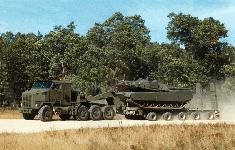
Ground mobility for Army helicopters frees the ground forces from having to in general, supply huge amounts of fuel so they can fly forward just to stay connected as part of the combined-arms team. This lowers the overall "footprint" of an expeditionary force on foreign soil. The fact of the matter is, that ground has to be taken and held FIRST before any kind of aircraft can land, anyway. So why not have the helicopters wait and move in trace of the combat ground elements until such ground for them to operate is secured? If the enemy air defenses or weather do not permit helicopter operations, the ground forces could lead the way, puncture an opening in the enemy's defensive crust and then once inside the enemy's system of defenses, helicopters could take flight. Instead of looking at a map and projecting and hoping an area is suitable for a Forward Arming and Refueling Point (FAARP)---which can be an up-close meeting with an enemy ambush---why not remove the internal demand pressure off friendly forces to accommodate attached aviation units and let them develop the situation on the ground?
As stated earlier, helicopters that are broke do not fly. Should the entire Aviation unit be stuck on the ground in the rear with them as the ground maneuver forces move ahead? Or why should the working helicopters displace forward as the injured helos stay back? If Army helicopters were truck-mobile, then even the non-flying helicopters could displace forward and stay close to the forward line of troops (FLOT) and as soon as they are repaired fly a short distance to render extremely helpful CAS. Helicopters that are downed could be recovered by PLS equipped trucks instead of blown up as the Apache was recently in Afghanistan. .
Helicopters as ground attack platforms, YES
As radical as the following may seem, consider an Army helicopter gunship on a PLS flat rack nose facing to the rear. Is there anything preventing it from firing rockets, cannon, machine guns and missiles from ordnance hard points?
Given a practical line-of-sight, why couldn't Army helicopters on HETS trailers and/or PLS flat racks be aimed by their trucks to become a firing battery of Hydra-70mm (2.75 inch) rockets to bombard an enemy position before a deliberate attack? Why couldn't these helicopters be powered up by an APU and run their sensors on the ground to scan and secure a part of a vehicle laager assembly area, to include firing guns if the enemy attacks?
Everything I've been describing is actually not a new idea; British Brigadier Richard Simpkin proposed in his book, Race to the Swift, that the next development of the helicopter would be it to fold its rotors and function as a ground combat vehicle as the situation dictates. Franz also proposes an Air/Land combat vehicle that can fly or move on the ground at will:
I take his idea further and propose a flying APC:
However, a new, revolutionary design air/ground craft for MANEUVER requires millions of dollars from a DoD bent on FIREPOWER bombardment and is not likely to happen. The best way to begin would be to create a PRACTICAL Air/Ground vehicle for the first time in history by adapting a 4x4 ATV into an autogyro, creating an outstanding recon and SF attack platform, since Afghanistan combat has shown the utility of all-terrain vehicles in these roles. OV-10 Bronco creator, retired USMC Colonel K.P. Rice is creating his Volante air/ground vehicle to do this for the civilian world which can be adapted to military uses once in production.
What I'm observing is that, a suitable separate truck transport capability could achieve defacto (Good enough for now) capability of what Simpkin wanted to do by special design; creating an air/ground vehicle. As you know, helicopters are VERY EXPENSIVE rocket/missile launchers and gun platforms that once on the ground provide nothing to the fight. Why accept this situation? Make these ordnance launcher help the fight on the ground when not flying.
Where do we begin?
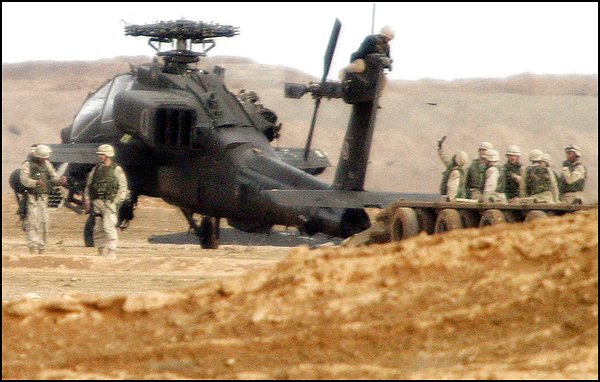
Well if HETs work moving 70-ton M1 heavy tanks, why not 7-ton AH-64 Apache and UH-60L helicopters? Its already happened: HETS has been used to recover downed CH-47Ds in the past. The Army has over 1, 179 HETs and trailers. What are they doing after they have delivered M1s, M2s to the battlefield? Why not as the M1/M2/M113A3s FIGHT and move forward have the HETs move the Army's helicopters clandestinely forward into FAARP sights as developed by the ground maneuver units if the weather, enemy situation, mission and logistics economy demands it?
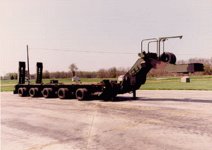
Manufacturer: Systems & Electronics, Incorporated (formerly Southwest Mobile Systems)
Tractor Compatability: M1070 / M911 / M746 / MK48 / MK16 / SLT50-2 / M916 and Future U.S. and NATO Tractors
Dimensions:
Length: 622"
Width: Overall - Rear Bumper - 144.8"; Trailer Bed: 119"
Height: Overall - At Handrails - 144"; Fifth Wheel @ CW - 65.4"; @ GCVW - 64.3"
Usable Deck: 403"[Editor: enough to carry a AH-64 or UH-60, even a CH-47!]
Minimum Ground Clearance: 15.8"
Curb Weight: 50,000 lb.
Payload: 140,000 lb.
Payload Capabilities: Self Load/Unload Disabled Tanks
Specifications:
Axles: 5 Axle Lines, 2 Half-width Axles per Line
Steering: Hydraulically Actuated Mechanical Linkage; Axles 2,3,4 and 5
Automatically Steer
Axle Vertical Travel: 20"
Suspension: Type: Load Leveling Hydraulic, Independent from Side to Side
Suspension Supports: 10 ea.
Brakes: Two-line, Straight Air with Spring-actuated Park/Emergency Features
Tires: Type: Radial, Michelin
Size: 215x75R17.5 Tubeless
Quanity: 40 ea.; Plus 2 Spares
Gooseneck: Type: Pivoting, Hydraulic, Load Compensating
5th Wheel Nominal Height: 63"
Kingpin: 3.5" Diameter; U.S./NATO Heavy Duty Standard, Removable
UPDATE 2003: GUESS WHO SHOWS US THE WAY?
WHY THE DEFEATED IRAQI ARMY!
Its a given that the Army must reorganize to combine arms better so artillery suppresses and masks for aviation etc. but the fact remains that the basic parameters we have set for ourselves are condemning us to these failures. We must co-locate Army Aviation units with the ground maneuver forces of our Army even if it means towing helicopters on trailers.
The photo below is of the Iraqis TOWING a captured AH-64D Apache LongBow helicopter shown on their TV. We should be able to LEARN FROM OUR ENEMIES (Needed Army values: humility, respect for the enemy). If a helicopter conks out, and the Iraqis can figure out how to trailer and tow it, then certainly we in the U.S. Army can do the same.
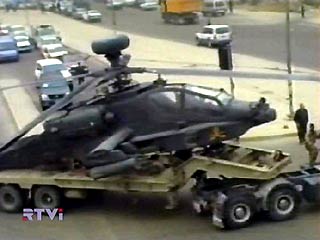
If helicopters with their V/TOL cannot operate alongside ground units, what's the point? If they are going to be far in the rear then that rear could have a runway for the same energy expended making comfortable tent cities. We cannot always count on a brilliant plan which skillfully combines arms to compensate for our own self-produced short-comings. There comes a time when we face our weaknesses head-on and FIX THEM and set the conditions for success. U.S. Army Armor branch has a lot of delusional thoughts about itself, however it has done one thing right; by making the M1 Abrams tank nearly invincible, it has carried the day at the platform technotactical level of war even when the plan was lacking.
The Little Bird is EASILY towed on a trailer
Here is a picture from a recent Florida air show. So do not even try to pretend like it cannot be done.
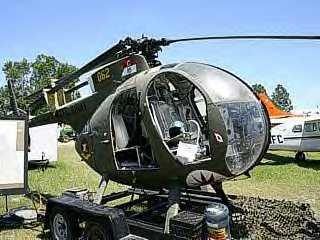
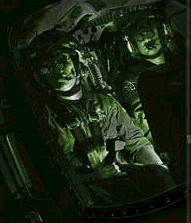 An Army AH-64 and UH-60L Captain writes:
An Army AH-64 and UH-60L Captain writes:
"Helicopters are usually flown from the factories. The natural frequency of vibrations incurred during normal operation (I would think) are a whole lot more than would be induced from travel over the road or terrain, as long as the A/C is winched securely to the transporter. Not really a big issue. I do think they should be completely encapsulated, so as not to be an easy target (maybe even with reactive armor hung on the side of the trailer to mitigate RPG threat). They could be easily stowed and removed with a simple winch system. The time consuming aspect is the rotor system. Trucks should be configured to allow for the helicopter to be transported with absolute minimal maintenance modifications such as kneeling, collapsing main rotor hub, removal of tail rotor, and horizontal stabilator dismantling, etc.
If all these things are required - you defeat the purpose of your intent."
Military futurist Stan Crist asks; "for M113A3-equipped BCTs, would it be feasible to ground transport OH-58D and/or AH-6 on M548A3 cargo carriers? Helo gross weights are well within the payload capacity of M548A3, but I don't know the relevant dimensions?
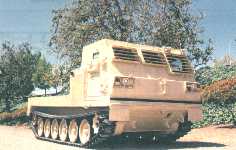
Above is a picture of the XM1108 "Universal Carrier" variant of the M113A3 Gavin. As most of you know, the M548 unarmored cargo variant has an open "pick-up truck" flat bed area to move cargo. The XM1108 solves the M548's vulnerability issue by putting the crew in an armored forward cab and still leaves the rear area open for cargo, a gun or howitzer...or in our latest application---a small OH-58D or AH-6 attack helicopter!
Because the back of the XM1108 is open with no sides the real issue is how to get the little helicopter UP onto the back if not landed there by flying. These helos are so small, that frankly we do not need an elaborate PLS flat rack system. Some "elbow grease" and some detachable ramps should get the skids of the helos with ground wheels attached up the ramps and onto the back of the XM1108. Then, securely strap down the helo, whose rotors would already be folded. Another option would be a winch to pull up and lower the helo up/down the loading ramps.
Great idea, Stan!
Even within the as-is M548 cargo bed walls offer 100 inches of width which will facilitate a little attack copter since the AH-6 skids are less than 1.9 meters (74.08 inches) apart! So initial "guesstimate" is YES. I even remember at the 1995 LeapFest that an OH-6 Little Bird was TOWED to the parachute competition with a truck and trailer.
In fact, OH-58D Kiowa Warriors and AH/MH-6 Little Birds can be carried INSIDE and transported in ISO containers!
www.tpub.com/content/hseries/TM-55-1520-400-14/css/TM-55-1520-400-14_170.htm
C 1, TM 55-1520-400-14 CHAPTER 8 TRANSPORTABILITY GUIDANCE, OH-6 HELlCOPTER
Section I. TRANSPORT OF THE OH-6 HELlCOPTER IN CONTAINER
NOTE
Minimum disassembly applicable to all surface modes is removal of main rotor blades and horizontal stabilizer. CAUTION TM 55-1520-214-S will be consulted before any disassembly and loading takes place.
CAUTION
Only container chassis trailers equipped with soft ride suspension system will be used to transport the container by highway to the port. The use of soft ride suspension chassis trailers within the port is not necessary. Deviations from the procedure will be authorized only by Commander. TSARCOM. Stuffing the container at locations other than the port is not recommended.
8-1.
Preparation Disassembly, preservation, and packaging are accomplished in accordance with TM 55-1520-214-S. Additional guidance may be obtained through contact with personnel of the U.S. Army Troop Support and Aviation Material Readiness Command, St. Louis, MO. To reduce congestion in the vicinity of the loading area, the main rotor blades, vertical and horizontal stabilizers, tail rotor, and mast and rotor head are removed prior to positioning the helicopter at the loading site. The main rotor blades are packed in a plywood container; the mast and rotor head secured to a skin-mounted base; the horizontal stabilizer is placed in a fiberboard carton; that is secured to the prefabricated metal spreader bar (para 8-4a): and the tail rotor and vertical stabilizer are wrapped in a protective material and secured in the helicopter cabin.
NOTE Remove antennas as necessary; wrap, identify, and stow in cargo compartment, as required.
8-2. Positioning For Loading
The loading site should be a loading platform equal in height to the height of the container floor. The helicopter can be moved short distances over smooth surfaces by means of ground-handling wheels, tow bar, and warehouse tractor. Maneuver the helicopter (with the aid of the ground-handling wheels) to the rear of the container and align the container door for loading.
8-3. Loading
CAUTION
Extreme care must be taken in loading and unloading helicopters to prevent gouging, scratching, or tearing the airframe skin.
a. General. Bridging material is to be placed directly in front of the landing skids. It consists of 1/2-inch (1.2 cm) thick plywood or 1/4-inch (.6 cm-) thick steel plate sufficiently wide to accommodate the ground-handling wheels and landing skids and long enough to span the distance between the loading platform and the inside of the container; extending beyond the rear door header. When safety requirements do not restrict, paste soap or grease may be applied on the bridging material to facilitate skidding the helicopter through the container door. The ground-handling wheels are removed and reinstalled after the high point of the helicopter clears the container door header. To help reduce the height of the helicopter, the landing skid struts may have to be extended to their maximum position and secured in the extended position, this is done with prefabricated spreader bars or with notched and cushioned 4- by 4-inch (10- by 10-cm) lumber spreader tiedown pieces. Approximate measurements of major removed and packaged components for each helicopter are as follows: Main rotor blades: 144- x 10- x 17 in. (366- x 25- x 43-cm) Mast and rotor head: 30- x 30- x 30-in. (76 x 76- x 76-cm) 8-1
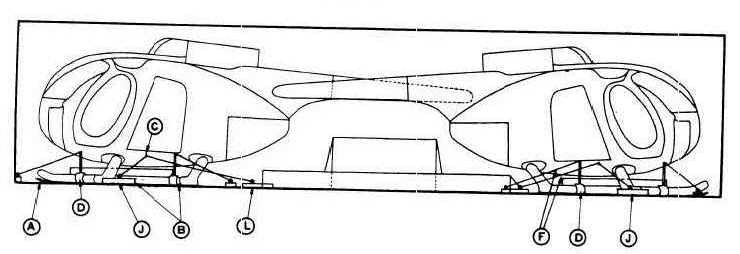
CHAPTER 4 TRANSPORTABILITY GUIDANCE, OH-58 HELICOPTER
Section I. TRANSPORT OF OH-58 HELICOPTER IN CONTAINERS
CAUTION
TM 55-1500-338-S will be consulted before any disassembly and loading takes place. Container chassis trailers equipped with soft-ride suspension system will be used only to transport the container by highway to the port. The use of soft-ride suspension chassis trailers within the port is not necessary. Deviations from this procedure will be authorized only by Commander, TSARCOM. Stuffing the container at locations other than the port is not recommended.
Preparation 4-1.
Disassembly, preservation, and packaging are accomplished in accordance with TM 55-1500- 338-S. Additional guidance may be obtained by contacting the U.S. Army Troop Support and Aviation Material Readiness Command (TSAR- COM), St. Louis, MO 63166. To reduce congestion in the vicinity of the loading area, the main rotor blades are removed and protected with cushioning material for later loading under helicopter cabin. The following items are re- moved, wrapped with cushioning material, and secured in the helicopter cabin: pitot tube, top anticollision light fixture, engine exhaust stacks, main rotor hub, main rotor drive shaft, main rotor mast, tail boom support, tail rotor blades, and antennas (as necessary). The verti- cal fin and horizontal stabilizer are removed and boxed. The tail boom section is removed, and the tail rotor rods are removed from the tail boom; then the tail boom is mounted on top of the helicopter fuselage.
4-2. Positioning for Loading
The loading site should be a loading platform with a height equal to the height of the container floor. Two ground-handling wheel assemblies are used for moving the helicopter on the ground. Each assembly consists of a wheel, support, and lever that is used to retract or extend the wheels. The wheels are manually oper- ated and are held in place by a lock pin. The helicopter (with the aid of the wheels) should be maneuvered to the rear of the container and aligned with the container door for loading.
4-3. Loading
CAUTION
Extreme care must be taken in loading and unloading helicopters to prevent gouging, scratching, or tearing the air- frame skin. a. General. Bridging material is placed be- tween the loading dock and container in front of the landing skids. It consists of 1/2-inch-(1.27-cm) thick plywood or 1/4-inch-(.63-cm) thick steel plate of sufficient width to accommodate the widest point on the helicopter and of sufficient length to span the distance between the loading platform and extending into the container beyond the rear door header. Approximate measurements of removed and packaged com- ponents for each helicopter are as follows: Vertical fin assembly: 86- x 451/4- x 61/4-in. (218- X 115- X 15.9-cm) Horizontal stabilizer: 81- x 20- x 7-in. (205.7- x 50.8- x 17.8-cm) b. Two Helicopters on Loading Skids in 35- or 40-Foot Containers. The two boxed vertical fins are placed on end, one on each side at the front of the container. The first helicopter is moved into the container nose first, with the aid of ground-handling wheels, and is positioned 4 inches (10 cm) from the front of the container with left rear end and right front end of the landing skids close to the sides of the container (fig. 4-1). The two boxed horizontal stabilizers are then placed side by side between the landing skids under the helicopter. The second helicopter is moved, tail first, into a position similar to that of the first helicopter with the nose 4 inches (10 cm) from the door of the container. The main rotor blades are protected with cushioning ma- terial and secured to the main rotor blade tiedown fixture under the second helicopter (fig 4-1
Here is a picture of two OH-58s in an ISO container:
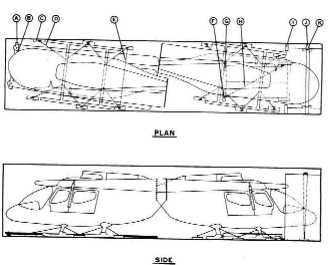
Thus, the small Army OH-58D Kiowa Warrior and AH/MH-6 Little Bird attack/transport helicopters could be hid in ISO containers and trucked to FAARPs and operated clandestinely.

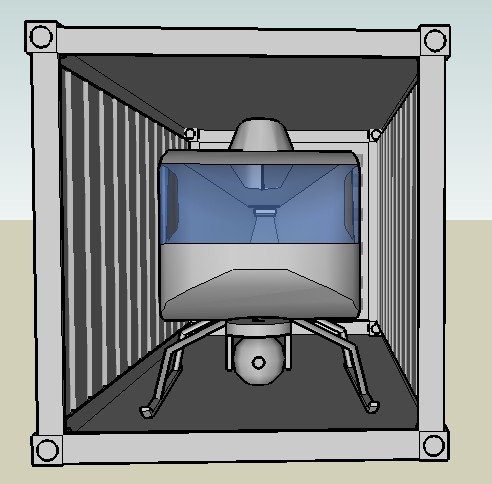
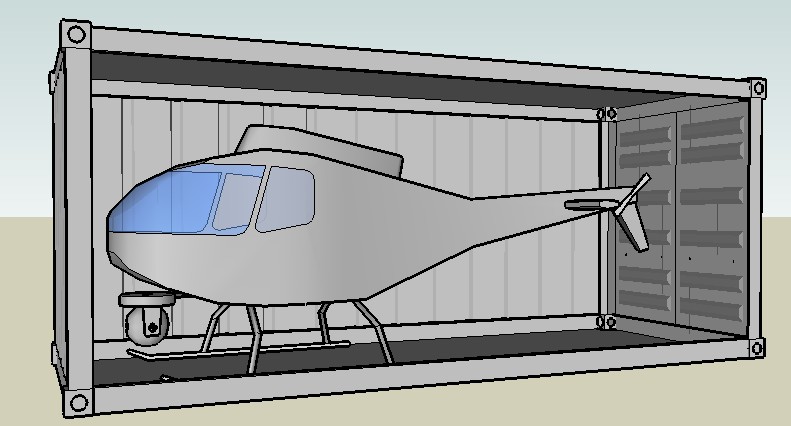
BATTLEBOXaircraftTM pictures
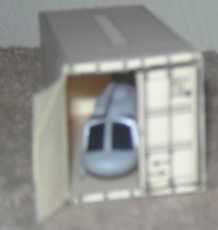
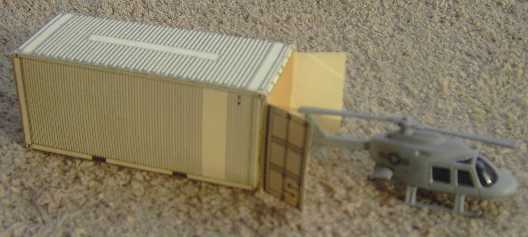
MD Helicopters A/MH-6 Little Bird
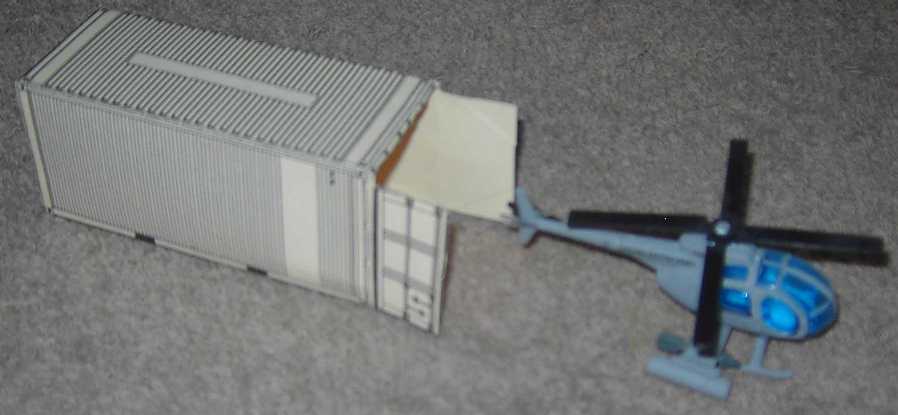



 www.youtube.com/watch?v=vXSqJmAffAo
www.youtube.com/watch?v=vXSqJmAffAo
The superior x-country ground mobility capability of tracked M548/XM1108s coupled with little attack helicopters would be a great force multiplier for Colonel Douglas Macgregor's LRSG and Airborne-Air Assault Group combined-arms teams. Colonel Macgregor already wanted to use Little Birds for CAS, anyway. A tracked, digital Brigade Combat Team (BCT) with such air/ground synergism is head and shoulders more capable of decisive maneuver and better firepower than the current, pathetic rubber-tired Stryker/LAV-III truck IBCTs.
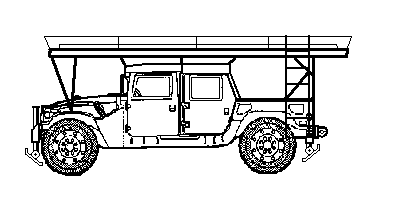
Legendary innovator, Carlton Meyer proposes going to even simpler piston-engined, enlisted pilot manned observation/attack/resupply helicopters to be "Killer Bees" rather than accident-prone UAVs. He suggests landing them on top of Humvee trucks with landing pads to offer landing light aids and avoid brown-out conditions. Details:
Here's a pic of a crop-duster helicopter in the U.S. that has landed on a mobile helipad on its mother spray truck:
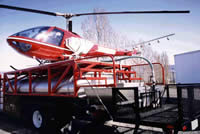
And here is how its done in Australia...
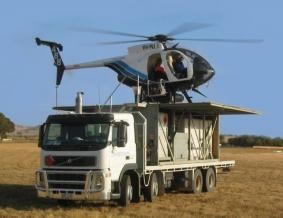
Aussies prove our ground-mobile helicopter concept: Mobile helicopter landing and maintenance facility, when is the U.S. Army going to do the same?
www.gizmag.com/go/4745
October 15, 2005 Australia's vast distances, harsh climate and isolated communities present major challenges for companies delivering vital services like electricity. To help in this environment, Brisbane-based Aeropower has developed a Volvo 380hp FM9 truck into a mobile helicopter landing and maintenance facility. Aeropower's Volvo-based mobile facilities for its fleet of Hughes MD500 helicopters plays an essential role in the aerial survey and maintenance of high voltage power transmission lines by providing not only a safer, elevated landing platform for its helicopter crew, but also fuel, water and maintenance provisions to maximise operating efficiency in the field.Even toy makers in communist China realize helicopters need help in the form of mobile landing pads:The portable helicopter landing and service unit is actually constructed from a standard 20ft shipping container fitted with a 4,000 litre fuel tank and a 7,000 litre water storage, all topped by a fold out landing pad. This allows safer refueling and landing for the helicopter while delivering fuel and maintenance closer to the areas where the Aeropower team is operating, reducing transit time between refuels.
Often traversing roads that are little more than dirt tracks the Volvo FM9 has proven its dependability in the toughest conditions ensuring it is always able to establish a mobile operations base close to where the helicopter is working. With its assistance Aeropower is able to move down the power line without the need to enter farmers' properties, eliminating the need to drive across and damage valuable crops.
Aeropower's Steve Jones believes it was the first company in the world to develop and operate mobile helicopter landing platforms. "We started using mobile landing platforms in 1992, but the original vehicle we used was not up to the task. We found that we could not fully load the unit as it would have been overweight on the front axle."
The problem led Aeropower to search for a replacement truck, a task that was made easier by Volvo's proactive attitude according to Steve, "We're not a trucking company, so we knew very little about specifying a truck and that is where Volvo really excelled."
"Volvo Trucks however came and met with us and used their Weight Information System (WIS) and Performance (Perf) programs to match our requirements with the appropriate specification truck," he added. "It was that sort of pre-sale service, combined with very competitive pricing, that led us to choose the Volvo."
The twin-steer Volvo FM9 has allowed Aeropower to fully utilise the potential of its helicopter landing and service unit now able to run with the tanks fully laden. The 4,000 litres of Jet Fuel - A1 and 7,000 litres of de-mineralised water means the fluids alone tip the scales at 10 tonnes and when fully loaded the Volvo FM9 comes in a tonne under its 28 tonne GVM.
The need to tackle rough country to be close to helicopter operations was another essential element for Aeropower and this meant the 8x4 chassis was the perfect choice. The FM9 comes standard with cross locks in each rear axle, and disc brakes with ABS/EBS added to the attraction and has resulted in tangible savings in terms of tyre wear. Steve attributes this to the way the Volvo FM9 puts its power to the ground and its smooth effective braking.
The Volvo FM9's specification enables Aeropower to utilise the truck through a diverse range of terrain from urban areas to rural bush tracks and to even some of the remotest parts of the Continent. Coupled to the D9A 380hp Volvo engine is the V2214, 14-speed split and range change transmission, which has the capability for high average cruising speeds - making it ideal for those long transport legs such as across Australia's Nullabor Plain.
The truck not only provides vital refueling and replenishment in isolated areas, but also delivers a safer and better landing facility for the Hughes MD500 Helicopters used by Aeropower. The level elevated landing platform three metres off the ground, keeps the helicopter clear of dust, which can be extremely damaging to jet engines. The platform also ensures the aircraft is clear of people on the ground improving the safety of operations and has allowed ground crews to get into areas they could not even contemplate in the past, further cutting transport time for the helicopter crews.
"Our operations are spread over a vast range of terrain and locations all over the country," said Steve. "We are currently operating in Western Australia, but soon we will be back on the east coast working in Far North Queensland, which gives you some idea of the sort of territory the Volvo FM9 has to tackle."
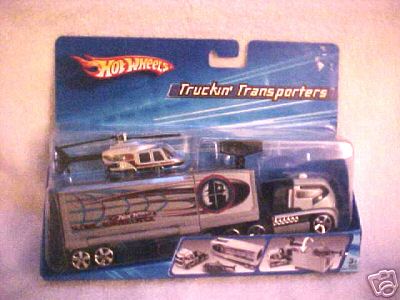
Here we repainted the HotWheels Helicopter truck-transporter in more tactical colors...
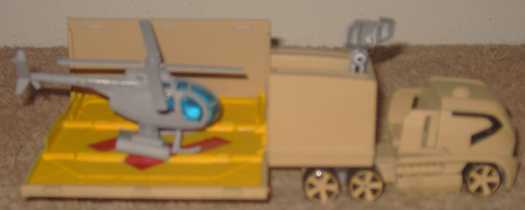
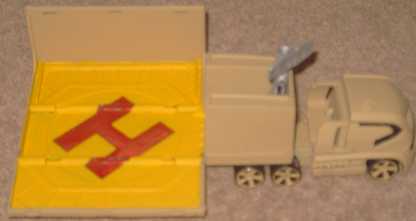
1
2
3
4
5
6
7
Bell 407
MD Helicopters A/MH-6 Little Bird
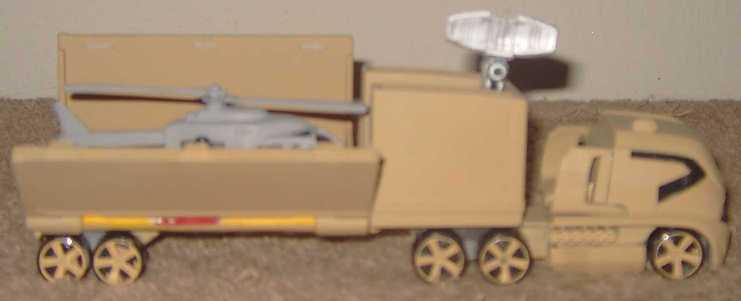
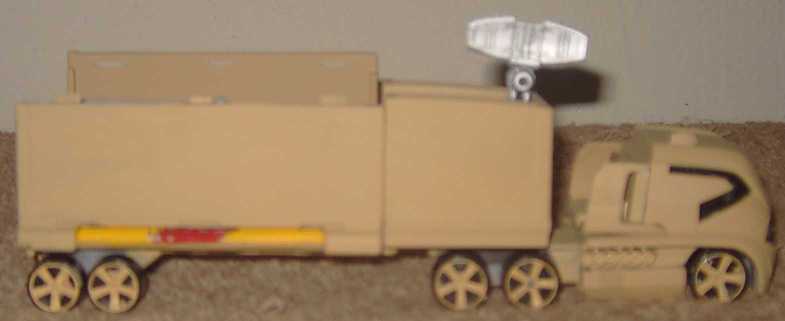
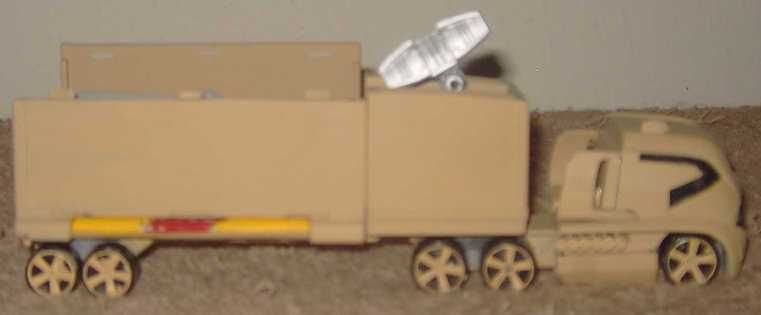
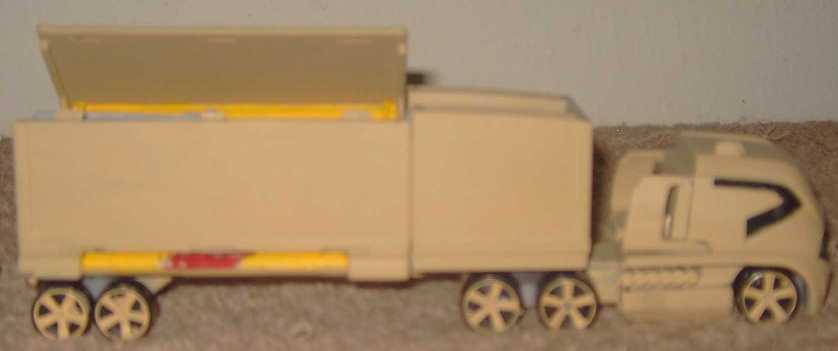
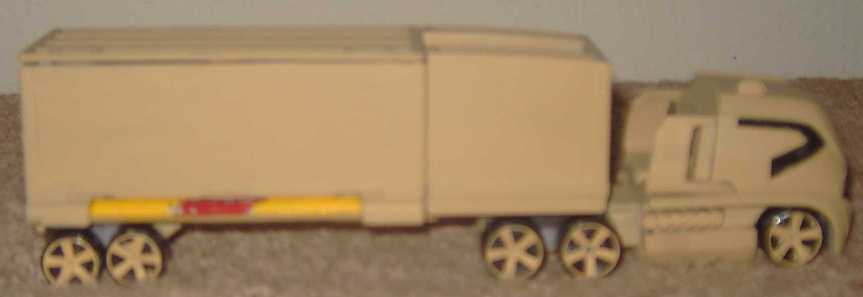
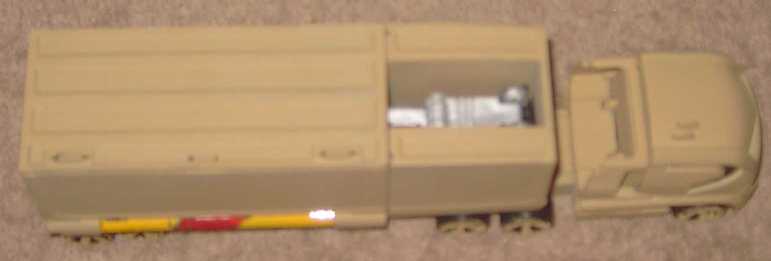


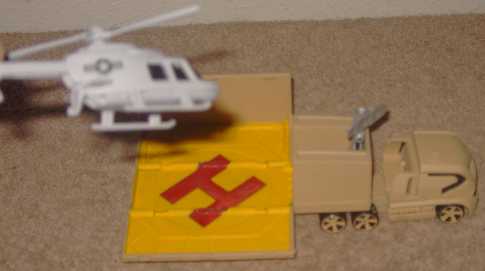
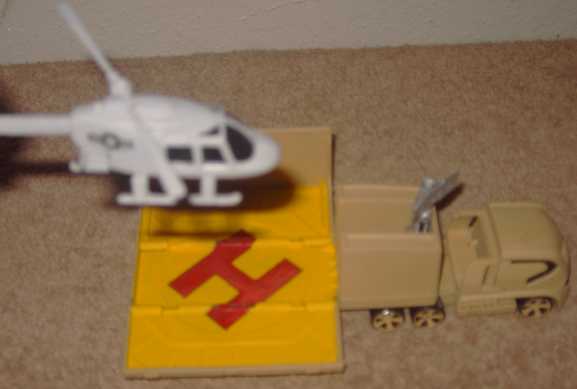

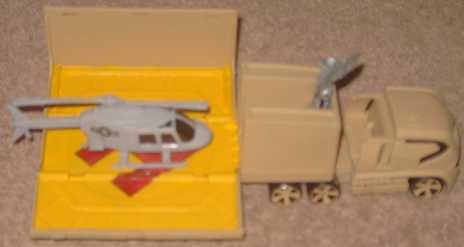
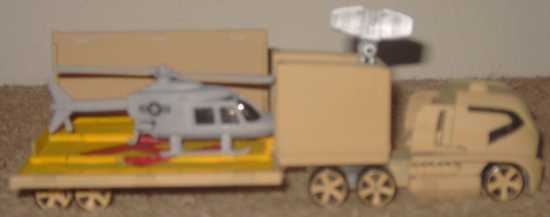
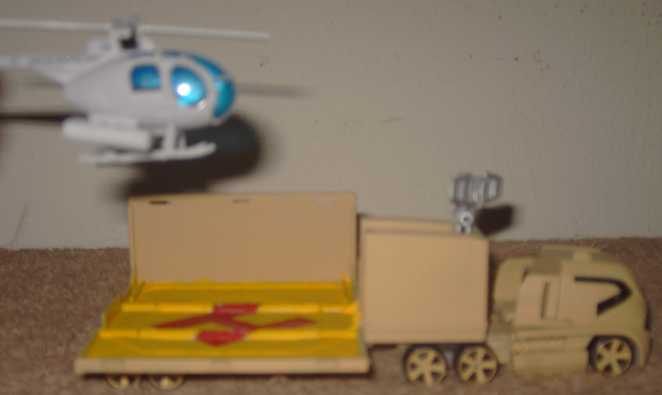
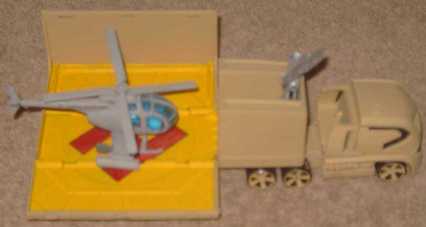
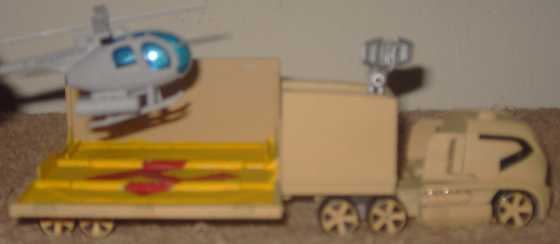
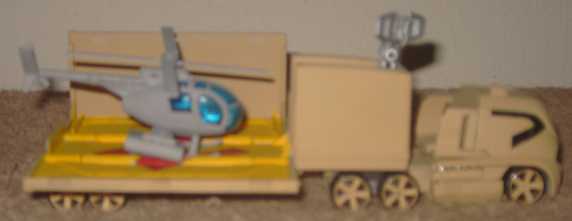
So here is a question.....WHY is it AOK for an "UAV" to be ground-mobile like the MMIST CQ-10A "SnowGoose" in U.S. military service (NSN 1550-01-505-3010) for resupply but not a MANNED aircraft?
UAV...AOK...
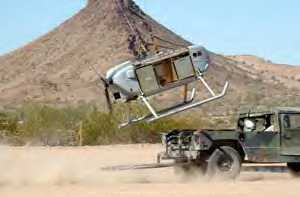
The NOTAR MD90 which hopefully will win the Army's LUH competition is a very COMPACT (compare to long tail-boom tail-rotor helicopters) and stealthy helicopter that could be easily ground mobile on a trailer or in a BATTLEBOXaircraftTM. Its got two powerful engines to counter the whining of narrow-minded rotorheads that NOTAR means loss of power. Getting shot down in flames because you are in a noisy helicopter is the "loss of power" (being DEAD) you should be worrying about.
Manned Aircraft NOT OK? Says who?:
MD-900 Explorer AS U.S. ARMY'S LIGHT UTILITY HELICOPTER (LUH) IN FORWARD-DEPLOYED SCENARIOS
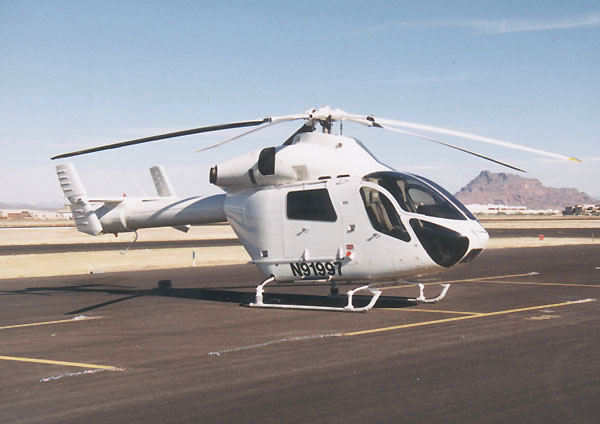
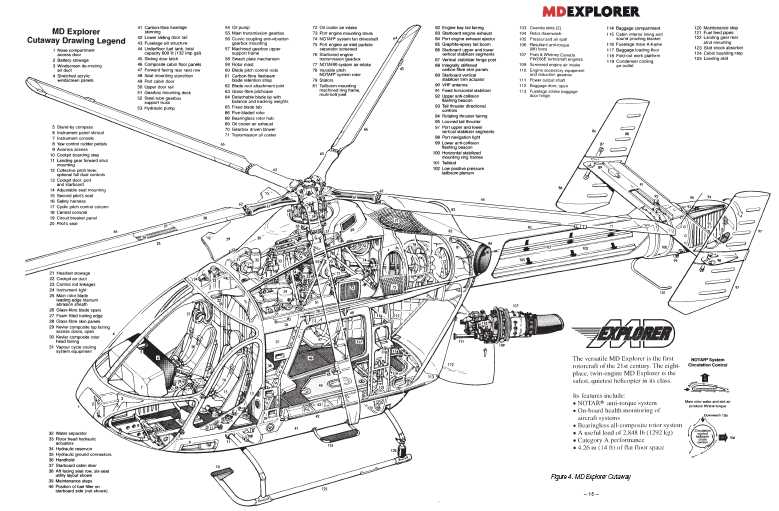
GROUND-MOBILE BY TRAILER TOWED BY OR ON TOP OF XM1108 GAVIN TRACKED AFV
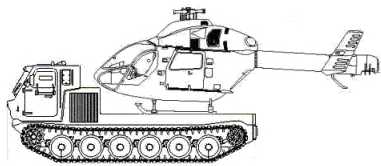
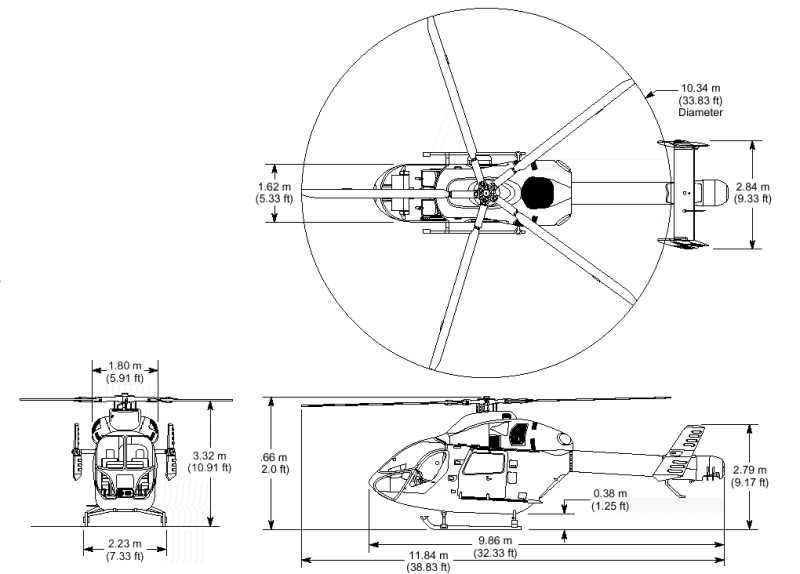
To be close to ground troops to be more responsive to their needs, as well as conserve fuel and flight time before maintenance, the MD-900 can be transported on the ground to forward operating locations (FOLs). Options to move Explorers include being moved on the back of XM1108 Gavin armored tracks (see drawing above) or on flat bed trailer:

To protect the MD-900 while on the ground, it can be partially covered
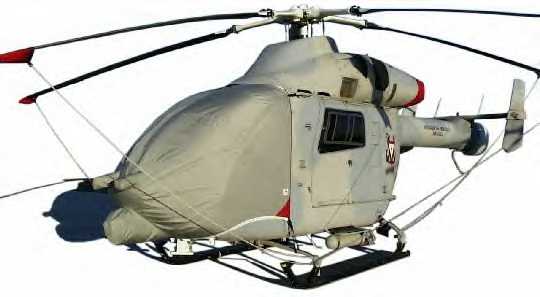
...or fully covered (as U.S. Coast Guard MD90s are on ships)
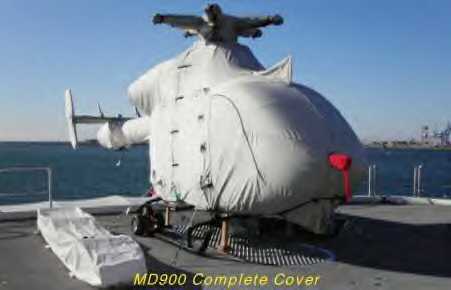
by Bruce Perch's Aircraft Covers
www.aircraftcovers.com/ techsheets/md900.html
www.aircraftcovers.com/mil.html
bruce@aircraftcovers.com
(800) 777-6405
(408) 738-3959
FAX: -2729
GROUND MOBILE BY ISO CONTAINER "BATTLEBOXes" ON MOBILIZER DOLLY SET WHEELS OR ON A TRAILER PULLED BY A TRUCK OR TRACK

Another, more protected and covert mobility option is to use ISO shipping containers. MD-900 LUHs can be transported inside a custom-made 40 foot long ISO shipping containers that would be higher (about 11 feet 6 inches) to fit the 10.91 foot high MD-900 helicopter with rotors removed. This shipping container would enable Explorers to be shipped overseas discreetly by container ship. The 40 foot special "BATTLEBOXaircraft" for the MD-900 can be insulated, have air conditioning, heat, water and electricity from wind, solar, pedal, batteries, fossil fuel generator, or a power grid hook-up and have fold-down bunks for Soldier air and ground crews to live inside.


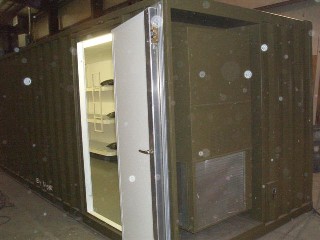
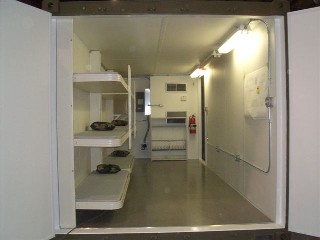
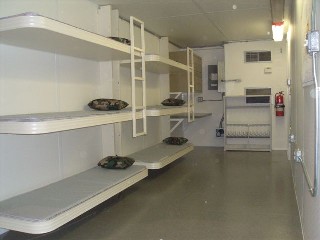
Another 20 or 40 foot long ISO container could carry an entire repair shop with tools and parts using expanding walls so MD-900s can be repaired inside out of the dirt, sand, heat, cold and wind.
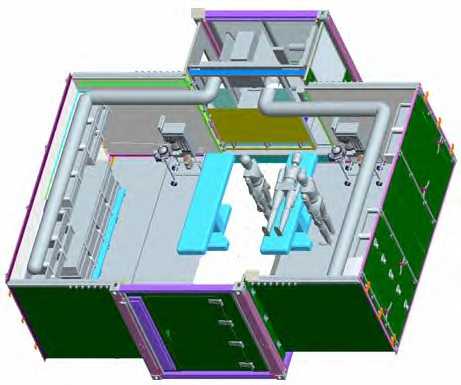
BATTLEBOXes come with outer wall sections for dirt to be filled inside to make them protected against roadside bombs, RPGs, bullets, rockets and mortar attacks.
HIGH-SPEED MD-900 LUH CARGO DELIVERY SYSTEM
There are no "safe", "rear" areas on today's non-linear battlefields. The MD-900 Explorer with its super-quiet stealth NOTAR control system eliminates tail rotor noise to be silent until right on top of anyone in the area. The compact size of the MD90 and its lack of a tail rotor to possibly snag of power lines, trees ands other obstacles enable it to put down where other copters can't--on today's rapidly urbanizing world this means more locations where the Explorer can get supplies in and wounded Soldiers out...
The stealthy, all-gray U.S. Army MD-900 Explorer LUH [www.mdhelicopters.com] silently crosses the sky blending in with its gray-blue colors then swoops down to the forward maneuver unit, not revealing its presence to the enemy due to its NOTAR stealth....
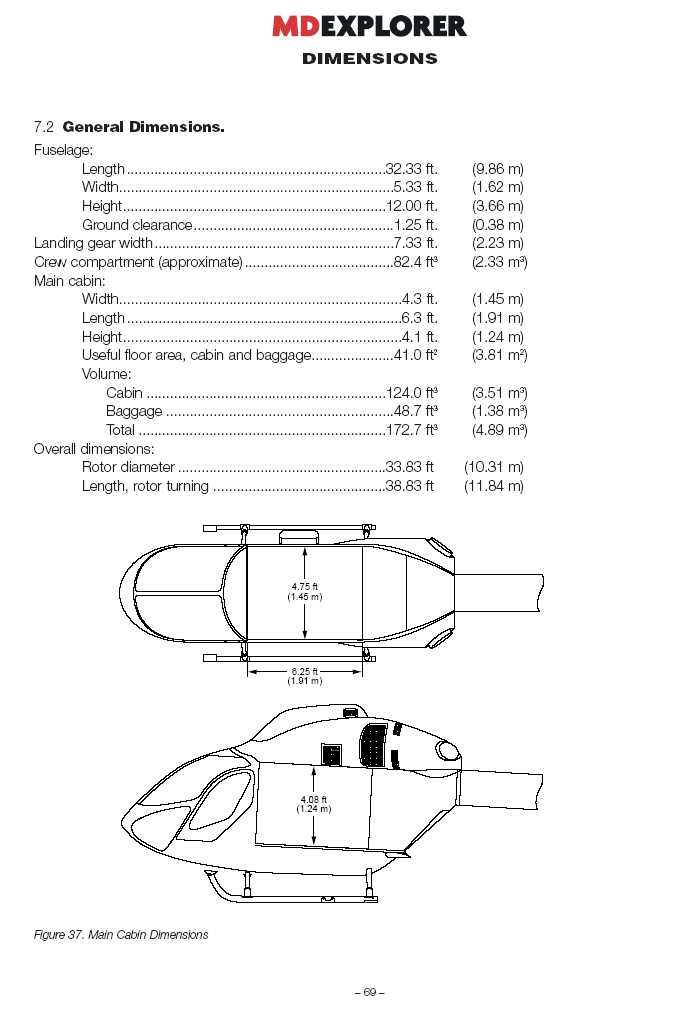
As the MD900 hovers a foot off the ground or taxies forward via ground handling wheels attached, bundles of ammo, food and water cargo on 3' L x 2' W x 2' H SKEDCO plastic sheets are pushed out by a crew chief out the rear compartment where the hatch was removed....they drop to the ground as the pilot gently moves slowly forward...
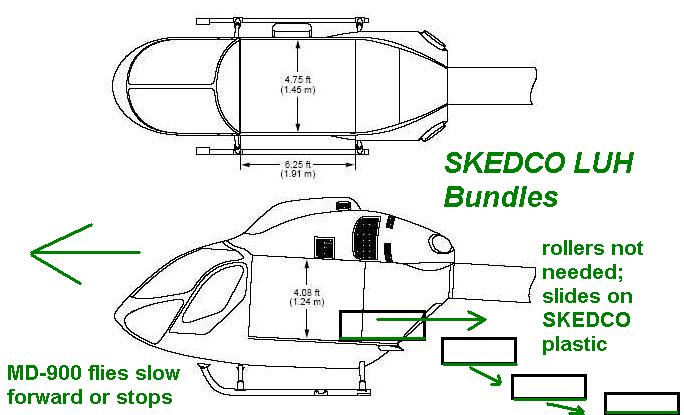
Another crew chief mans on the right side a M240B 7.62mm medium machine gun....
The MD-900 Explorer LUH lifts off and the "kicker" grabs his 7.62mm x 51mm M16A5 and points it out the left side of the LUH...soon the NOTAR chopper is gone....the whole operation is over in less than 1 minute...and the troops in need have the supplies to win the fight...the troops can drag the SKEDCO bundles to safety and distribute supplies out of danger...
NEW! First Metal Models of NOTAR MD90 Helicopters! Matchox "Air Blade"
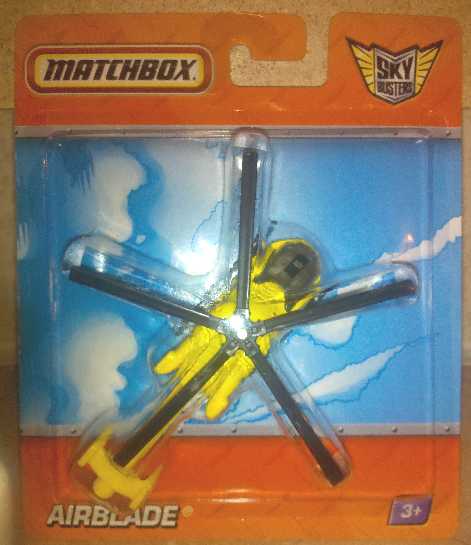
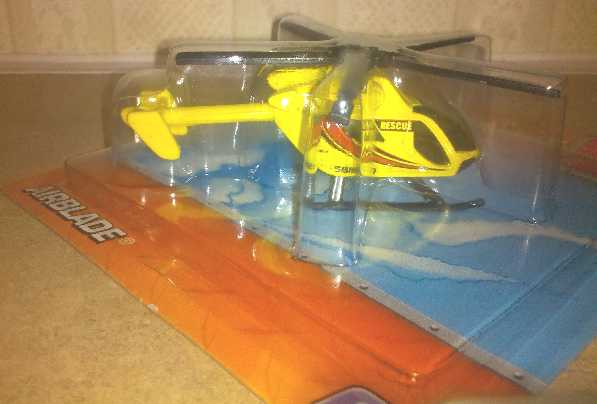
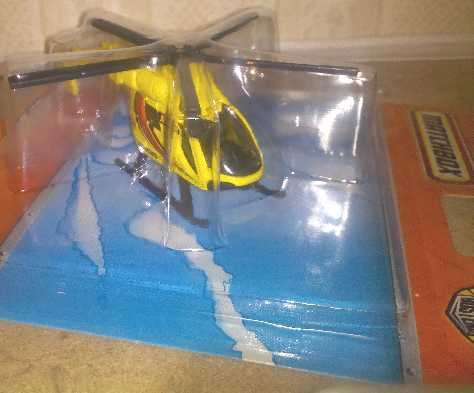
Ground-Mobile "Killer Bees"
Consider an Air Cavalry Squadron of 12 x A/MH-6 Little Birds and 12 x XM1108s organic to a tracked BCT or the 160th Special Operations Aviation Regiment (160th SOAR). When moving without flying, the Aircrew and Mechanics sit and drive themselves and their Little Bird from the front armored cab of the XM1108 Gavin. A ring-mounted machine gun on top with gunshield could provide self-protection fires as they move x-country along unpredictable avenues along with the rest of the tracked BCT in regular M113A3 Gavins with infantry troops and/or scouts lead by M8 Buford AGS light tanks. In the case of the 160th during special operations, the XM1108s could be the vanguard of the ground link-up force meeting the Little Bird delivered Rangers/Delta operatives who will not get stranded because their tracked and armored mobility will not be stopped by enemy barricades, small arms fire, Molotov cocktails as rubber tired armored cars and trucks were on October 3, 1993 in Somalia. The XM1108s could have an armored pod that would fit to the rear area to carry SOF troops firing outward to support ground link-up operations. Or a larger front can could be fitted to carry a fireteam in addition to the driver and top machine gunner. All of the vehicles could be rolling on quiet band-tracks with or without hybrid-electric drives covered with infared camouflage for very stealthy movements. After an Air/Ground assembly area is secured, the Little Birds are rolled off the back of the XM1108 Gavins and rotors unfolded. They can fly attack missions firing Hellfire ATGMs, unguided or laser guided 2.75" Hydra-70 rockets, .50 caliber HMG pods or 12 of the Little Birds could carry via external bench seats 72 infantrymen in one lift! The same capabilities exist for the OH-58 Kiowa Warrior. This is a 21st "Super Cavalry" version of the 11th ACR which in Vietnam had a Air Cav helicopters ORGANIC to the armored ground Cavalry! An Air-Mech-Strike "LIGHT" capability.
The Little Bird sips fuel compared to its bigger brother UH-60s and CH-47Ds....241 Liters equaling just 63.6655 Gallons (U.S.), thus the small attack helicopter's platform fuel requirement is almost the same as a M113A3 Gavin which has 95 gallons in its two side armored external tanks. After the Little Birds return from a mission, they will probably need a full tank refuel. The XM1108s could carry in their cargo area rear, FLEXCELL fuel bladders* of either 50 or 80 gallon sizes delivered by fixed-wing aircraft airdrop (freedrop). Think of FLECELL as "Camel-Baks for armored vehicles". The FLEXCELLs are simply pushed off the back of the XM1108 and the vehicle runs over the bladder to force fuel via a hose into the Little Bird needing fuel. Simple. No pumping units and elaborate steps. One 50 gallon bladder essentially refuels a Little Bird if it lands with some reserve fuel on-board (usual occurrence). We have sped and greatly simplified fuel logistics for the tracked BCT and made the small attack/transport helicopters of their organic Air Cav Squadron easily sustained for combat operations.
USAF: what about fixed-wing attack aircraft with ground mobility?
We began our discussion with the V/TOL helicopters (actually V/STOL if helicopter has wheels for a rolling take-off/landing) needing a "nest" to operate from, and giving them ground mobility so the nest can be developed from the ground-up instead of being forced from the air-down. The ideal fixed-wing attack aircraft would be the U/MCAV ASPs described by Chuck Myers in his MAS concept and our Killer Bees web pages because they are smaller, use less fuel and are lighter to be easily made ground mobile. However, brilliant war theorist, Ralph Zumbro asks:
"Mike;
Let's get WAY out of the box.
I just got the one from Carlton where he mentioned the transporter for the Abrams and that triggered another one.
If that carrier will take an Abrams, it will take a Harrier jet, and suddenly we've got a forward landing pad on wheels. Just land the ship on a carrier, fold the wings and go. If you sufficiently harden the deck to take blast, you should be able to use JATO bottles to take directly off the deck with a usable load of ordnance, after all, we just eliminated the long flight from the aircraft carrier to the strike zone.
Comment??"
Ralph,
you and the rest of us are realizing that the real culprits are the flyboys in the Army, AF and marines who don't want to get their fingers dirty. The helicopter, the A-10 and the AV-8B could all be operated aggressively from forward air strips in the dirt etc. but are not. The next layer of BS excuses they use is the PLANNING requirement that when the ground forces move they have pre-arranged a FIXED air base to move into....We solve this requirement by giving them GROUND MOBILITY via a ride on PLS trailers and a flat bed on the back of a XM1108 tracked armored vehicle.
Now what's their excuse?
The ducted thrust on the AV-8B isn't good enough or safe enough so the Joint Strike Fighter (JSF) is going to have ducted lift fans so instead of resting on a cushion of air that you can easily fall off, you'll have positive lift like a helicopter. Even though we could JATO for a zero/zero take-off with bombloads, the pilots will be too scared to do it in event that the JATO bottles misfire (?) and/or their engine fails and they smack down into the earth, burn and explode. Their isn't enough time to eject etc. The intelligent Brits use a ski jump when rolling their Harriers off a carrier deck for take-off providing extra ummph of lift and in event of engine failure valuable seconds to eject. The USN/marines roll Harriers off flat flight decks so pilots will not have any lift or time to eject so they can crash and die.
Your point is valid---why not take a Short Take-Off and Vertical Landing (STOVL) capable JSF and put it onto some sort of trailer and truck them to forward arming and refueling airstrips for combat operations to expedite their use and get away from fixed airbases easily attacked by asymmetric enemies?
Fixed-Wing Aircraft: Warthog-in-a-box?
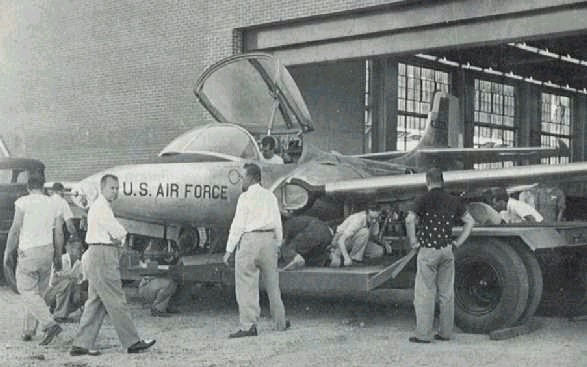
The tiny A/T-37 Dragonfly series of aircraft would be easily made sea/air/land container, trailer mobile as this picture showing a T-37 being moved by a small trailer demonstrates
See more on Fighter-in-a-box concept:
OA-37D U/MCAV Fighter-in-a-Box Concept
Today's fluid battlefields are revealing the need for aircraft to be more available and flexible in order to strike at increasingly fleeting targets. Army helicopters should be ground mobile through trailers to better covertly operate from Forward Arming and Refueling Points (FAARPs); so should Air Force fighter-bombers with missions to support ground maneuver troops. Details:
combatreform.org/helicoptergroundmobility.htm
Armored Sea-Air-Land MILVAN ISO container "BattleBoxes" should be used to transport fighter-bomber fixed-wing aircraft via trailers/prime movers with an outer sacrificial SOA wall to pre-detonate any RPGs and defeat heavy machine gun bullets. When operating from a FAARP or even a fixed-base the armored box would protect the aircraft from enemy air base rocket, mortar, artillery and small arms fire attacks. The box in essence becomes a mobile hardened shelter so we do not have to work around aircraft by supplying them large, fixed bases to hop into and out of. Mechanics can do maintenance on the aircraft not only out of the sun and cold but free from dust and dirt. Inside the armored box, the aircraft is not visible as an aircraft to the enemy to key on to attack it. Since aircraft in general are weak and vulnerable on the ground, its obvious that they need an armored cocoon and some mobility on the ground.
We have long used ships to move aircraft across oceans to eliminate the risks of losing pilots and planes while ferrying them. Its problematic that air refueling tankers, bases to land and refuel may not be available. However, the fragile nature of aircraft has led to them being gingerly carried on the flat decks of aircraft carriers used as a transport ship, placing both ship and aircraft at risk from enemy attack. By placing aircraft in armored boxes that stack we can avoid having to work around their weakness and can transport them in common container ships. Also, we do not have today extra unused aircraft carriers hanging around like the USNS Card which ferried Army helicopters to Vietnam in 1965. Shipping aircraft across oceans saves wear and tear on them so we have more capability when we really need it: in combat not just moving from point A to B. The same applies to conserving fighting powers moving by trailers and prime movers on the ground using armored boxes.
Where do we start for fixed-wing aircraft?
Army helicopters can detach their rotors so all we need is armored boxes large enough for them. For the AF, we should start with the A-10 "Warthog" which needs a second seat in back for an Airborne FAC enlisted observer, new engines and new wings. Details:
combatreform.org/aircommandos.htm
The new wings should FOLD like the old Grumman Hellcats of WWII so the Warthog could fit inside an armored transport box.
Sadly, the A-10's maker, Fairchild Republic has long been out of business and over the years so no company has been fighting to upgrade the A-10, and look at new employment concepts like "Warthog-in-a-box". The A-10 is orphaned. Thus, the greatest armored jet CAS in history is in danger of retiring out of neglect because it has no military industrial congressional complex (MICC) advocate. We must not let this happen! Armored box capabilities in conjunction with 2-seat OA-10Bs with folding wings more powerful engines and improved less than 3,000 foot runway STOL capabilities would revolutionize and improve USAF/Army air-ground cooperation and bring back the "Cactus Air Force" capabilities we lost when jets required long fixed runways.
Today's Non-Linear Battlefield (NLB) demands that aircraft support ground maneuver by being as close to the troops as possibly while not becoming inviting targets for the enemy when not in the air. Armored mobility boxes for aircraft can effect this transformation which will only get better with the advent of STOVL F-35 Joint Strike Fighters for interdiction missions on top of A-10s for Close/Maneuver Air Support. By not offering the enemy easy targets, and only striking hawks from the sky, perhaps he will seek more constructive lines of work.
Phil West writes in about military ISO containers that could be used as "battle boxes" for tanks and aircraft:
"As I recall, the container that caught my eye was an expandable mil spec unit...from a Norwegian company named Uniteam (at www.uniteam.org) ,it was designed as a command post or something, with the sidewalls sliding outwards (like a Caravan or RV's "tip-out" rooms) to convert from a standard container-width, to triple size after being towed to a destination. Made for NATO.
Exterior view:
http://www.army-technology.com/contractors/field/uniteam/uniteam3.html
Interior view:
http://www.army-technology.com/contractors/field/uniteam/uniteam4.html
Uniteam International AS
Tevlingveien 23
PO Box 200
N-0614 Oslo
Norway
Tel: +47 23 14 22 80
Fax: +47 23 14 22 90
Email: international@uniteam.no
URL: www.uniteam.org
*FLEXCEL: LIQUID CONTAINMENT SYSTEM
The Flexcel Liquid Containment system is a self-contained liquid storage system which can rapidly dispense its contents (fuel, water, decontaminates, oil, etc.), from a rubber bladder for military and/or commercial use. The Flexcel fuel system and the FAST fuel system have been sole-sourced by the Dept of Defense from FMW. These liquid containment systems are available in different configurations, sizes, and military/commercial use. Use requires no special equipment or training making it the simplest way to move and use liquids. Uses include helicopter and aircraft transports refuel LAV transport and refuel, M1A1, and M1A2, main battle tank refuel and other vehicular refueling capabilities. Field refueling is Flexcels specialty. Units can be air dropped, without a parachute to military tanks and armored personnel carriers. This system also transports and delivers water for emergency situations, oil, other fuels and several decontaminates. With no moving parts and high reliability and re-usability, Flexcel has been tested and is in the U.S. Army and U.S. Marine Corps inventory. Early this year, FMW sold several kits to Egypt. A demonstration in August has resulted in a second contract under negotiation, with continued sales for the next several years being discussed. This system is currently available in 55 and 80-gallon sizes, with a kit containing two bladders each. Modifications are available for commercial use. This system has been tested and used by the U. S. military and foreign countries and has a long-term shelf life and is reusable. Flexcel can operate in extreme temperatures and environmental conditions arctic to desert.
Deployment Concept:
Flexcel is either tied to the side of the turret of the vehicle or laid across the back deck. It can dispense fuel by gravity feed or can be dropped onto the ground and the vehicle drives up on the bag and pushes the fuel out while the hose is inserted in the vehicle fuel tank. Upon completion of the fueling operation the cell can be dropped off the vehicle or left attached.
It has quick disconnect straps in the event the crew wants to jettison the device and is built to survive a 30 ft. drop to the ground. As depicted, heavy-duty Cleves straps are used to affix to the side of the vehicle.
Flexcel ranges in size from a 50-gallon version to the larger 80-gallon version. Any size Flexcel can be produced to meet the customers needs.
FEEDBACK!

Our Army helicopter pilot Captain writes:
"OH-58's, and AH-6's could probably just utilize an all terrain dolly. Similar in design to what is used to pull them in an out of the hangar, except for the durability of the design and wheels. Use Sparks' design for all terrain CART but on a larger scale. Pintle towed, etc. It doesn't take much to move those little birds. Maybe throw in a couple oleos for a bonus suspension."
